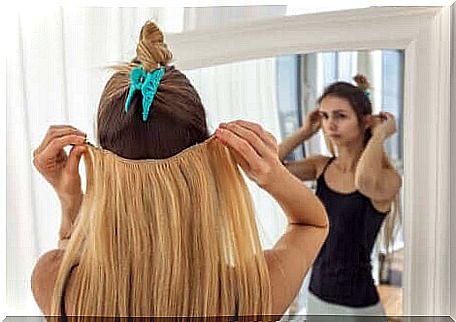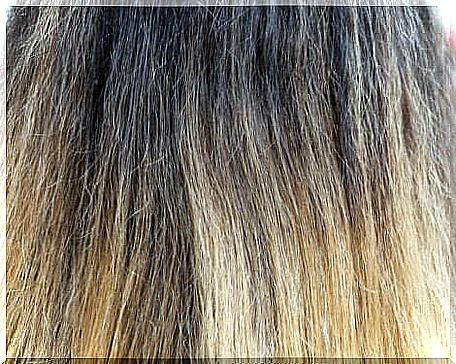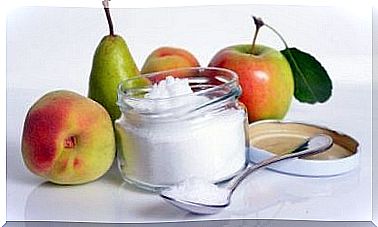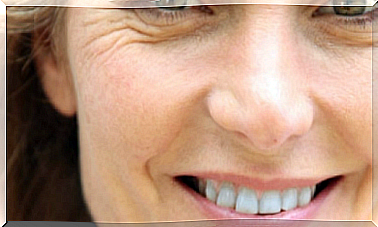Wearing Hair Extensions: Is It Risky?
Hair extensions of any type involve risks to hair health. Those of permanent or semi-permanent use can in particular cause significant damage to the hair.

Hair extensions are a beauty technique that involves adding sections of natural or synthetic hair to lengthen the hair or make it more voluminous. Even though this is one of the most widely used aesthetic methods in the world, you should know that it involves several risks.
Models like Naomi Campbell have said that hair extensions have given them different hair problems. Despite this, these additions continue to be used without further precautions. But why can hair extensions cause problems? What should we know about them? We will explain it to you right now.
Types of hair extensions
There are different types of hair extensions. They differ depending on whether they cling to the hair or the scalp. In the same way, the techniques which are employed for their fixing determine variations in their degree of risk.
Adhesive extensions
In this case, a special glue is used to attach the extensions to the scalp. They must be placed and removed by a hairdresser and the adhesives used must be hypoallergenic. However, they are not always.
Braiding extensions
This is a widely used technique which is also very harmful to the hair. It consists of making horizontal crowns with very thin braids. These are tucked in the middle of the hair and the extensions sew to these braids. The good thing is that we don’t use any chemicals or heat. The negative side is that these extensions create weight and produce strong traction.
Extensions with rings or staples
These are semi-permanent extensions, which are attached to the hair and last between two and six months. With this technique, we take strands of hair and join them to an extension with a ring or a clip. This process should be performed by an expert hairdresser. It causes strong traction on the hair.
Silicone and keratin
This is a technique similar to that of adhesives, which involves fixing silicone or keratin on the scalp to hang the extensions there. It should be done every three or four months. For fixation, one must use heat, compressed air or ultrasound. These extensions also cause traction on the hair.
Fixing with clips
This is the least harmful option. The strands of hair that are added have one or more clips that can catch on the hair. They are then removed, as one would with pliers or a bar. Usually, these extensions are only used for special occasions and only for a few hours.

What are the risks of hair extensions?
None of the types of extensions mentioned are harmless, but anyway, the most harmful techniques are those that involve keeping them longer. We are now going to detail the risks to which you expose yourself by using these additions.
Hair loss
This is one of the risks that is present in almost all types of extensions. Since these are attached to the hair, they prevent it from falling out naturally. So, by the time you remove them, it is possible that a large volume of hair will suddenly fall out.
Chronic mechanical irritation
Extensions exert traction or tension on the hair follicles. In the long run, they can end up being atrophied, and as a result, the hair will become thinner. In the most serious cases, we see alopecic patches or “bald spots” in several places of the head. If the extensions stop being used, the process is reversible; otherwise, no.
Deterioration
Extensions can damage the hair cuticle. At first, this causes a decrease in the shine and vitality of the hair. Then we can see them become more fragile and eventually break.
Scalp lesions
There are cases where hair extensions produce lesions on the scalp. More particularly, it is possible to see folliculitis, which is the inflammation of the hair follicles. If this happens, red papules appear and sometimes fill with pus, causing pain and itching.
Allergic reaction
Although not very common, some people have allergic reactions to used glues or extensions. In this case, they should be removed immediately and a doctor should be consulted.

Is the use of hair extensions recommended?
Beauty should not come before health. So, in general terms, using extensions is not recommended as they all involve risk. If using them is really important for a person, it is best to use them in moderation and only occasionally.
Sometimes they are used to cover up types of alopecia. However, these are cases that require caution as certain techniques only worsen the condition and can cause inflammation and irritation of the scalp.
The most advisable is not to double the length of natural hair so that the traction is not excessive. Likewise, you should go to a professional hairdresser to advise you on the most suitable form of extension, depending on your hair type and the quality of your hair health.
Recommendations for using extensions
If you decide to use extensions, it is best to choose natural hair extensions, not synthetic ones, as they are easier to wash and maintain. It is also necessary to set up a good routine of care to minimize the possible adverse effects.
It is not recommended to dye the hair to even out the color as it may make it drier. In addition, you should use the hair dryer in moderation and style your hair delicately. Think about it!









